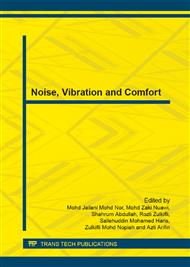p.255
p.261
p.267
p.273
p.279
p.285
p.293
p.299
p.306
The Effect of Direct Field Component on a Statistical Energy Analysis (SEA) Model
Abstract:
Statistical Energy Analysis (SEA) is a well-known method to analyze the flow of acoustic and vibration energy in a complex structure. The structure is divided into subsystems where the energy in each of the subsystem is assumed to be reverberant. This study investigates the application of SEA model in a 'damped' acoustic space where the direct field component from the sound source dominates the total sound field rather than a diffuse field in a reverberant space which the SEA model assumption is based on. A measurement was conducted in a scaled room divided into two acoustic spaces separated by a partition with an opening. Absorbent materials were installed on the room walls and the power injection technique was implemented to obtain the coupling loss factor (CLF) of the system. It is found that correction of the direct field component from the subsystem energy improves the prediction of the CLF of the system.
Info:
Periodical:
Pages:
279-284
Citation:
Online since:
December 2013
Authors:
Price:
Сopyright:
© 2014 Trans Tech Publications Ltd. All Rights Reserved
Share:
Citation:


